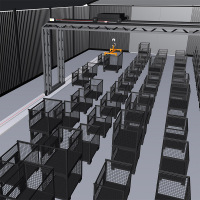
Rack control unit - lift height
The frequently used automatic rack control units make modern warehousing much easier. These units must automatically travel long distances and position the products with millimetre precision at the end. Modern optical laser sensors and also draw-wire sensors are used to monitor this movement. Draw-wire sensors are the more economical solution for distances up to 50 metres. Laser sensors which determine the distance using time of flight measurement are suitable for larger distances. Distances can be precisely measured and loads can be exactly positioned or delivered with their help.
|
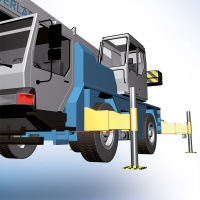
Crane support distance
A truck-mounted crane is frequently the better solution in many cases where loads have to be lifted. As a mobile solution, safety also plays an important role here. Therefore a load torque limiter controls whether the crane can still lift or not. In order to ensure the maximum permitted load, the side crane supports must always be completely extended. If this would not be possible due to lack of space, the crane could not be put into operation. The dynamic process for measuring how far the crane supports have been extended facilitates a calculation of the permitted load capacity. Thus, the use of truck-mounted cranes can also be ensured where space is restricted.
|
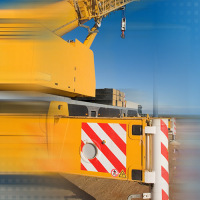
Lift platform – lift height
Side supports against tipping over are installed for lift trucks and lift work platforms. The crane or the platform can only be put into operation when the supports are completely extended so that there is also no danger of tipping in the case of long extension frames. However, sometimes this is not possible for spatial reasons. Therefore draw-wire sensors from Micro-Epsilon are used for measuring how far the supports are extended. A dynamic load torque limit across the actual support area is thus produced. Redundant measurement is performed as this is a safety relevant measured value.
|
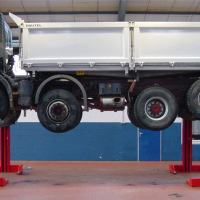
Synchronized lifting system lift height
Mobile lifting jacks are being used more and more often for commercial and railed vehicles. The lifting jacks for commercial vehicles are often designed as column lifts. In contrast, railed vehicles are often lifted on the frame. Any number of these lifting jacks can be combined into one system. As each lifting jack has its own drive for the lifting movement, the individual devices must be synchronized in order to ensure a completely level and oscillation-free movement. The lifting movement of each lifting jack is measured with a draw-wire sensor for this.
|
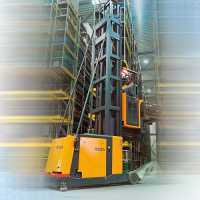
Forklift lifting height
A large part of internal transportation is performed by forklifts. The risk of tipping the forklift when products are lifted is high. Therefore, the permitted speed has been restricted with limit switches. Draw-wire sensors from Micro-Epsilon measure the current lift height and make continuous speed regulation possible, depending on the height of the products.
|
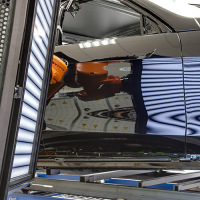
Fully automatic paint defect inspection of car bodies and attachments
Particularly with shiny surfaces, a faultless production chain is expected in order to lend a sophisticated visual appearance to the final product. For fully automatic defect detection on car bodies and attachments, the reflectCONTROL inspection system is used. The system projects a striped pattern onto the surface. Deviations caused by defect are recorded with two cameras and evaluated via software. |
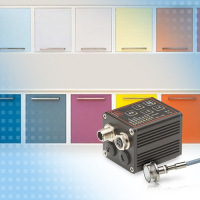
Color recognition of kitchen fronts
In order to ensure consistent color of different front panels, color sensors from Micro-Epsilon are used. The sensors inspect the color of the kitchen fronts in the painting plant. Color sensors ensure that the color shade is within the specified tolerances. Even the smallest color deviations imperceptible to the human eye can be detected reliably. |
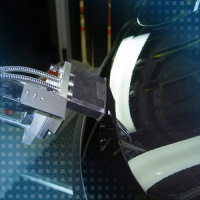
Color inspection and sorting of supplier parts
Before installing front aprons, Micro-Epsilon color sensors check if the color of the attachment matches the body color. Different color groups can be defined to cover all coatings. |
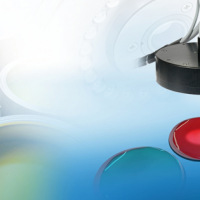
Color measurement of liquid paint
Measuring the color of liquid paint is extremely complex. To date, paints have been typically applied on a test area first and then measured only after the drying process in order to achieve reliable measurement results. If the measurement results reveal that the paints are faulty, the paint containers must be mixed again or even disposed of which partly involves long waiting times until a new measurement process can be started. In order to accelerate this process, Micro-Epsilon has developed a system that enables the measurement of liquid paint during the production process. This application therefore includes the colorCONTROL ACS7000 color spectrometer for color measurements and the optoNCDT 1420-50 laser triangulation sensor for distance measurements. The latter is ideally suited to this application due to its compact size and excellent performance. A linear unit offers automatic readjustments. |
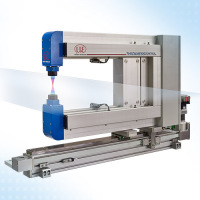
Two-sided thickness measurement
Depending on the respective measurement task, it is sensible to carry out a two-sided thickness measurement. Arranged opposite the material, two displacement sensors detect the thickness. This measurement arrangement is particularly suitable for high speed measurements and fluttering materials. Micro-Epsilon also offers sensors and turnkey systems for two-sided thickness measurements. |
